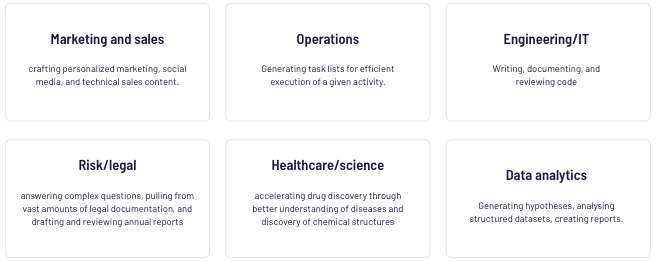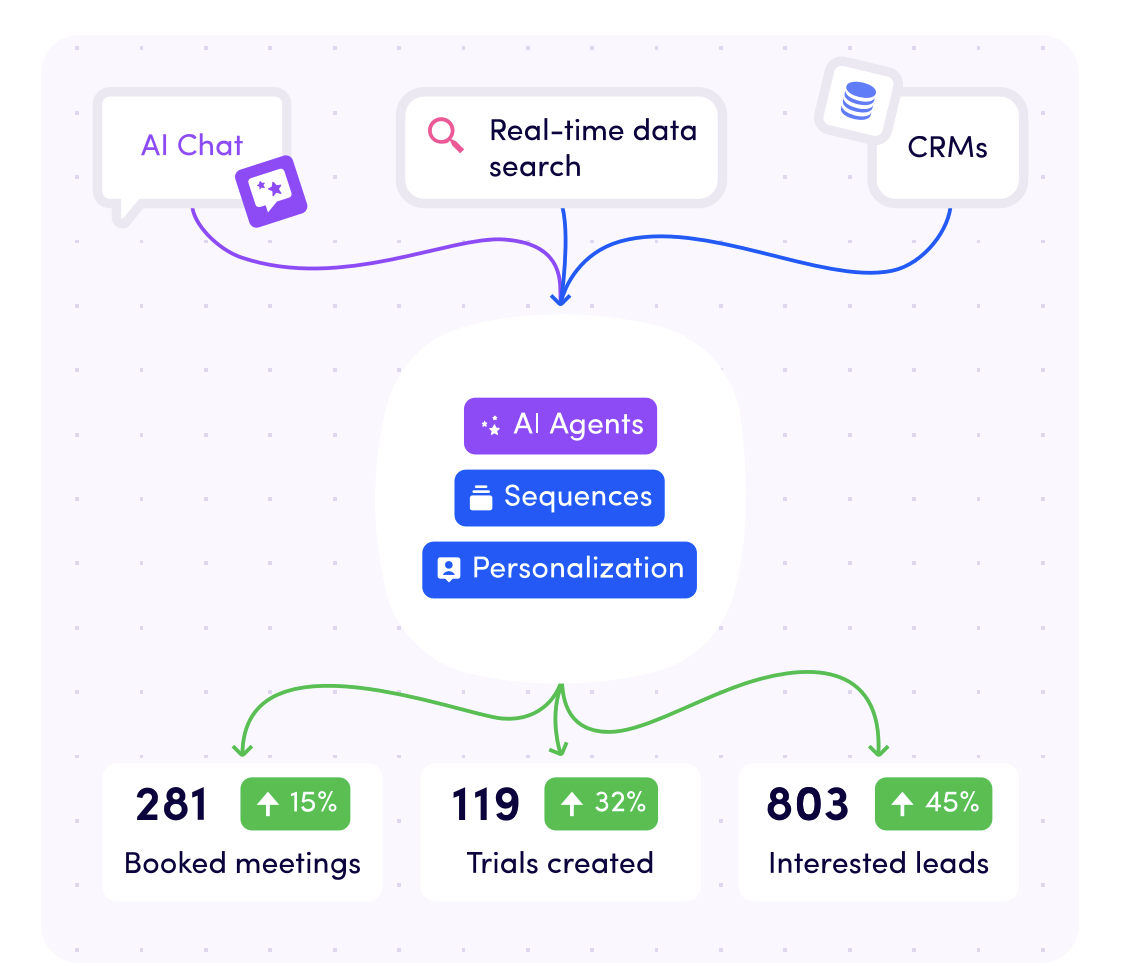Practical steps for AI implementation in your business

Artificial Intelligence (AI) is the missing piece of the business puzzle, completing the picture of a more efficient, productive future. But putting it in place isn’t just about technology; it’s about aligning AI with your company’s unique needs and people.
CNN named AI “Word of the Year” because of the changes it brought!
Whether it's changing how we do customer service or making our shopping trips feel super personal, AI is becoming a part of our everyday lives.
Let's explore how AI is transforming business operations and shaping our future!
In this article, we'll discuss:
- AI definition
- Benefits of successful AI implementation
- Step-by-step AI Implementation Strategy:
- Step 1: Identify the Main Goals to Grow Your Business
- Step 2: Set Realistic Expectations
- Step 3: Choose the Right AI Tools and Technologies
- Step 4:Train Your Workforce on AI Adoption
- Step 5: Implementation Process with Existing Systems
- Step 6: Start with a Pilot Project
- Step 7: Measure AI Impact and Optimise
- Risks of not implementing AI correctly
- Wrapping up
- FAQ
AI definition
In today's world, AI seamlessly blends with our routine tasks. We hardly notice it.
But do you know what it is?
Artificial intelligence (AI) is the simulation of human intelligence in computer systems, allowing them to mimic processes like learning, reasoning, and self-correction.
Through AI, computers are designed to learn from data inputs and make decisions based on that knowledge.
One key method is natural language processing, which helps machines understand and interpret human language.
But it doesn't stop there!
As AI evolves, a new frontier emerges: Generative AI.
It goes beyond analysing data—it creates new content, like text, images, or even music, based on patterns it learns.
Instead of just analysing or classifying information, it generates new outputs that mimic human-like creativity.
Think of it as AI’s creative engine, always generating fresh ideas from what it knows.
Now that we know the definition, let's dig deeper!

What are some examples of how to apply AI?
Simply put, it's the process of integrating AI technologies into your business operations. Think of efficiency, innovation, productivity, and continuous learning.
This involves designing, developing, deploying, and maintaining AI models or systems that can perform tasks traditionally done by humans, such as recognising patterns, analysing data, predicting outcomes, and learning from experience.
To fully understand a successful implementation in your organisation, here are a few use cases.
1. Customer Service
Remember when you were put on hold by the customer service you needed to talk to?
Well, those days are over! Say hi to fully automated AI chatbots to boost your customer service experience.
These chatbots are basically your virtual assistants, available 24/7 and ready to answer any customer queries and even provide personalised product recommendations.
A good example is H&M ChatBot. Not only does it answer basic questions, but it also shares the company's vision for a more sustainable future in fashion.
.png?width=1920&height=1080&name=03-Customer%20service%20(1).png)
2. Predictive analytics.
No more tarot card reading predictions!
Predictive analytics checks historical and current data to estimate future events using statistical modelling, data mining methods, and machine learning.
Take Netflix, for example.
It tracks your viewing habits and suggests 80% of the shows you end up watching based on your preferences.
It also creates tailored thumbnails based on the scenes you liked.
Netflix’s AI employs machine learning, data mining, and statistical modelling to predict trends, optimise content creation, and improve user experience.
The goal is to optimise the feed based on your preferences.
By making the browsing experience more personalised and engaging, Netflix helps you discover new shows and movies that suit your tastes, enhancing your overall experience on the platform.
That's how they not only got your full attention but made your experience much more personalised!
But this isn't just about offering a personalised experience.
Boosting sales and customer engagement involves making data-driven decisions to resonate with your audience truly.
Are you ready to implement AI into your organisation? Discover the most important steps here. 🚀

3. Personalised customer preferences.
Isn't it great when you walk into your favourite coffee shop, and the barista remembers your usual order?
Just like that barista knows exactly how you like your latte, AI picks up your preferences and habits to tailor every interaction.
“Applied in the proper ways, AI can help develop new, trusted personalised experiences that make every customer feel like they are the most important.”
- says Frank Keller, executive vice president of PayPal.
Look at Amazon—they cracked the code!
As a result of their AI initiatives, during their 2024 Prime Day event, they generated $13 billion in global sales!
Using data analysis allows them to whip up spot-on personalised recommendations.
That's the reason for their huge boost in cross-selling and upselling!

4. Content Generation:
No budget for a graphic designer?
No worries—Generative AI has got your back!
It helps businesses to produce personalised, high-quality material at lightning speed.
Tools like Persado and Copy.ai leverage AI to craft content that resonates with specific audiences, boosting engagement.
Instead of having to manually create content for each audience group, these AI tools quickly generate personalised messages based on what each audience likes and how they behave.
This makes sure that every piece of content is spot-on and interesting, which boosts the chances of grabbing the audience’s attention and getting them to act!
And here’s the kicker: The CMO Survey provides actionable insights; businesses utilising AI for content creation have seen a 6.2% increase in sales and a 7% boost in customer satisfaction. With AI, you can scale your content production like a pro while taking your customer experience to the next level.
For more tips on boosting your productivity with AI, check out our webinar on AI for Productivity and Tools.
5. Risk management:
Catching red flags straight away!
AI can take care of risk safety for you, whether it’s some odd behaviour or sketchy transactions.
It's a pro with fraud detection, checks transactional data and picks up the patterns indicative of fraudulent activities, all in real-time.
In predictive analytics, AI sifts through tons of data to forecast potential risks, ensuring you’re not caught off guard.
For compliance monitoring, AI continuously tracks evolving regulations, ensuring you remain compliant and free from legal hassles!
A good example is Intesa Sanpaolo, which became the first European bank to adopt AI for regulatory purposes. Through collaboration with Aptus.AI, they streamline regulation management, assess impacts, identify risks, and automate document creation.
On top of that, the AI Rapport from DeNederlandscheBank shows that 60% of European banks are utilising AI in their systems.
Thanks to that, banks can protect their and your financial peace.
So let's sum up all the perks! 👇

Benefits of successful AI implementation
Firstly, it automates your team's routine tasks, letting them focus on the essentials.
Secondly, it personalises customer interactions, boosting loyalty and satisfaction across the board.
Besides that, it helps you to make faster and smarter decisions by turning your data into useful analytical insights.
And last but not least, AI reduces errors and cuts costs, making your decision-making processes more efficient.

All this sets you up for faster growth and greater success.
Pretty convincing, right?
Well, AI business implementation can be a bumpy road if you are unsure where to start.
So let's take a look at some important steps to take!
Ready?
Step-by-step AI Implementation strategy
Step 1: Identify the Main Goals to Grow Your Business
Know what you are aiming for! Having a structured direction always helps to move faster.
Are you looking to automate routine tasks, streamline business processes, or gain deeper insights from your data?
For example, your business goal is to streamline customer support.
Then, you might aim to implement an AI chatbot to handle common enquiries and free up your team for more complex issues.
💡 Pro Tip: Use the SMART method to outline the business objectives trajectory!
- Specific: Clearly define what you want to achieve. A specific goal focuses on a particular outcome or result, leaving no room for ambiguity. For example, instead of saying, "Increase sales," say, "Increase sales by 10% in the next quarter."
- Measurable: Make sure you can track your progress. Set concrete criteria to measure your success, like using numbers or milestones to evaluate how close you are to your goal.
- Actionable: Your goal should be within your control and require actionable steps. Define the specific actions you'll take to achieve it, ensuring you have a clear path forward.
- Realistic: Set a goal that is challenging but achievable given the resources, time, and skills you have. It should push you but still be attainable within your current situation.
- Timing: Assign a deadline or time frame to your goal to maintain urgency and focus. A clear time frame keeps you accountable and on track.
Here's an example of a SMART-goal statement:
Our business goal is to [quantifiable objective] by [timeframe or deadline]. [Key players or teams] will accomplish this goal by [what steps you’ll take to achieve the goal]. Accomplishing this goal will [result or benefit].
Source: K. Boogard- How to write SMART goals.
👇 Define a clear business case for each area to understand if AI is worth further investigating.
Step 2: Set Realistic expectations
Still here? Well done, because you made it halfway through the article already. 🎉
Before starting, it’s crucial to set clear, realistic expectations.
While AI can transform your business by streamlining operations and improving efficiency, it’s not an instant fix.
Start by identifying specific areas where AI can provide real value—whether it’s automating customer service, improving decision-making, or analysing large volumes of data.
Also, it’s super important to keep everyone on your team in the loop about what to expect.
AI isn’t here to take anyone’s job; instead, it will handle routine tasks, allowing your team to focus on more important work.
By getting everyone on the same page from the get-go, you’ll make it way easier to bring in AI and ensure it works out well in the long run.

Step 3: Choose the Right AI Tools and Technologies
Now it’s time to choose the tools that will get you there.
Different AI technologies suit different business needs—whether it’s machine learning algorithms, natural language processing (NLP), or computer vision.
Do you need a cloud-based solution like Google Cloud AI or AWS?
Or perhaps you're looking at tools like HubSpot’s AI integrations for marketing?
Whatever the case, make sure your tools can scale with your business and work seamlessly with your existing tech stack.
💡Pro tip: Look for tools that offer flexibility in model training, so you can tailor the AI’s learning process to your specific data and needs.
Step 4: Train Your Workforce on AI Adoption
As we mentioned, your team should also be ready!
Make sure everyone gets proper training for a smooth AI integration.
You should encourage your team to not be afraid of this advanced technology!
You can start by sharing this AI quiz with your team to see what the base level of everyone is.
As a next step, engaging in a dedicated AI course would be helpful!
Check out this AI for Business course to help you and your team boost productivity with AI solutions and make data-driven decisions for the future.
Don't be afraid if you meet some resistance —changes are difficult, but they are inevitable for effective business growth.
With proper handling, AI integration into the company's culture will soon become an untouchable part of it.
Step 5: Implementation Process with Existing Systems
This is where the real magic happens!
Start by pinpointing the key areas AI can boost—like customer support, marketing, sales, and operations.
Not sure? Check this table for the possible business cases with AI implementation.
Also, you need to check that AI tools can seamlessly connect with your current software and platforms.
Using HubSpot? Your AI should be able to sync with these systems to provide real-time insights and automation.
If you are unsure which tool can help you optimise your business the best way possible, check out our ultimate guide with growth-hacking AI tools.
Keep in mind that integration is not just about plugging in new tech; it’s about ensuring data flows smoothly between AI and your existing tools.
That's how you can keep on rolling!

Step 6: Start with a Pilot Project
As tempting as it may be to dive head-first into AI across all departments, resist that urge.
Start small, start smart.
Launching a pilot project allows you to test AI in a low-risk environment. For instance, your goal is customer service automation. Then it's better to start with a chatbot in a specific department rather than company-wide.
The pilot phase is all about continuous learning.
What works?
What doesn’t?
Gather insights, refine the AI system, and based on that, tweak your strategy.
This way, by the time you’re ready to scale AI, you’ll have concrete data to back up your decisions and the confidence to move forward.
Step 7: Measure AI Impact and Optimise
Once your AI pilot is up and running, the work isn’t over!
Now, it’s time to measure the impact. Are your objectives being met?
Track key performance indicators (KPIs) like customer satisfaction, cost savings, or process efficiency.
Make sure to gather feedback from both your team and the data.
AI is an evolving tool, so continuous optimisation is key. Adjust the model as needed to fine-tune its performance, ensuring you get the maximum value from your AI investment.
Risks of not implementing AI correctly
When implementing AI, it's essential to approach it carefully to avoid major pitfalls.
If AI isn't implemented the right way, businesses can run into all sorts of issues, from sketchy predictions to privacy concerns.
AI presents quite a few risks if not managed well.
Especially with the latest AI EU Act launched in 2024, check it out here.
Can AI make mistakes in forecasting? Of course, at the end of the day, it's still artificial intelligence. Incorrect predictions can lead to poor business decisions. That’s why it’s crucial to double-check AI’s conclusions and make informed decisions yourself.
Not everything is predictable. While AI learns from vast amounts of data, its decisions can sometimes be difficult to explain, so it won’t fully replace human analysts.
Data privacy. Using neural networks may need access to personal customer data. This can increase the risk of data breaches. Understanding what data is being used to train the model and the potential consequences is essential. Making sure personal data is secure when using AI should be a top priority.
But don't worry too much! By managing things well and following the instructions carefully, the implementation process will provide clear benefits for your business.

Want to Learn More About AI for Business?
You are in the right place! AI is an exciting field that's making huge waves in the business world.
As tech keeps advancing, AI is becoming more practical for everyday use in various roles and industries.
AI is all about saving time and boosting productivity across the board.
It’s not just a futuristic dream anymore—it's here, it's real, and it's ready to roll.
So how can you learn more about using AI in business?
As a leading educational course provider, we created the most effective AI for business course you can find!
This course will help you and your team boost productivity with AI solutions and make data-driven decisions for the future.
6 Modules | 24 lessons | 24 videos | 6 tests | 6 exercises
- Module 1: AI and Machine Learning Fundamentals
- Module 2: AI business strategy
- Module 3: GenAI for text: ChatGPT and prompt engineering
- Module 4: GenAI for design: text prompts and visual communication
- Module 5: AI for Productivity Module 6: AI-powered predictive insights
👉 Check out our course here
.png)
Wrapping up
AI is no longer a luxury—it’s a necessity for businesses ready to scale faster, work smarter, and deliver more value.
By strategically implementing AI, you can automate routine tasks, personalise customer experiences, and make data-driven decisions that drive growth.
But remember, AI is only as powerful as the people and processes behind it.
Success lies in adopting AI thoughtfully, training your team, and constantly optimising for the future.
Now’s the time to embrace this game-changing technology and position your business ahead of the curve.
The future isn’t waiting! Let’s go make it happen. 🤖
FAQ
How do I know if my business is ready for AI implementation?
Start by identifying key areas where AI could deliver value—whether it’s automating tasks, improving customer service, or generating insights from data. Assess your current tech infrastructure and ensure your team is ready for the change. Pilot projects are a great way to test readiness before going all in.
What’s the first step in implementing AI in my business?
Define clear business goals and identify the processes that can benefit the most from AI. Use the SMART method to set actionable and measurable objectives that AI can help achieve, whether it’s boosting efficiency or enhancing customer experiences.
How do I choose the right AI tools?
Choose AI tools based on your specific business needs. Whether you’re looking for machine learning algorithms, chatbots, or predictive analytics, make sure the tools are scalable, integrate well with your existing systems, and offer customisation options to fit your unique goals.
How long does it take to implement AI?
The timeline varies depending on the scope and complexity of the AI solution. Starting with a pilot project typically takes a few months, allowing you to test, measure, and optimize before full-scale implementation. Keep in mind that AI is a continuous learning process that evolves over time.
Will AI replace jobs in my company?
AI is here to enhance, not replace, human jobs. It automates repetitive tasks, allowing your team to focus on more strategic, creative, and complex work. By embracing AI, your workforce can become more efficient and productive, leading to better overall performance.
What if AI doesn't deliver the results I expect?
AI implementation is a learning curve. If the initial results aren’t what you hoped for, refine the system based on data and feedback. Measure KPIs, optimise your processes, and ensure proper training. AI's real power lies in its ability to adapt and improve with time.
How do I ensure data privacy when using AI?
Data privacy is critical when using AI. Be transparent about the data you're collecting, secure sensitive information, and ensure your AI tools comply with data protection regulations like GDPR. Regularly check your AI systems to find and reduce possible risks.
How much does AI implementation cost?
Costs can vary a lot based on your AI project. They can range from cheap off-the-shelf solutions to custom AI systems. Start small with pilot projects and scale up based on proven results. Don’t forget to factor in training and ongoing optimisation.
What is the biggest risk of not using AI?
The biggest risk is falling behind your competition. Businesses that don’t adopt AI will struggle to keep up with those that leverage it to optimise operations, improve customer experiences, and make data-driven decisions. In today’s fast-paced market, AI is a key driver of success.
Categories
- Business & Innovation (83)
- Growth & Marketing (72)
- Artificial Intelligence (53)
- Data & Analytics (16)
- Case studies (10)
- Project Management (10)
Related articles
Latest articles
AI in Finance: Why You Need It Now
Imagine a world where loans are approved in seconds. Sounds...
ChatGPT Search Unveiled: Should You Make The Switch Now?
Picture this: You’re no longer just “searching” the web—you’re...
Shadow AI Explained: How to Harness Hidden AI Without the Risks
Picture this: your team is under pressure to deliver results—fast....
The 33 best AI tools for commercial teams
The tools are split into 2 categories The best AI tools for your...
















